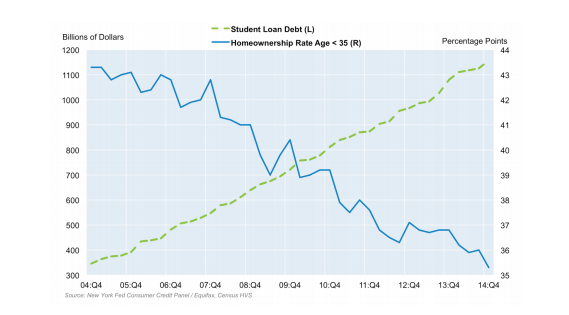You are viewing our site as an Agent, Switch Your View:
Agent | Broker Reset Filters to Default Back to ListSix Real Estate Trends to Watch for in 2016
December 16 2015
 With the national unemployment rate holding steady at 5% and stable job growth continuing in a number of industries, 2016 looks to be a promising year for economic and industry advancement.
With the national unemployment rate holding steady at 5% and stable job growth continuing in a number of industries, 2016 looks to be a promising year for economic and industry advancement.
For the real estate industry, the forecast is optimistic – especially for sellers, as home values continue to climb.
Here are six real estate trends to watch for in the New Year.
1. Demand for housing will continue to grow
2015 proved to be the housing market's most profitable year since the recession, and sales of existing homes are expected to grow moderately in 2016. According to Lawrence Yun, chief economist of the National Association of Realtors®, "Sales activity in 2016 will once again be primarily driven by the ongoing release of more pent-up sellers finally realizing their equity gains and using it towards the down payment on their next home."
The market is primed for current homeowners who plan to transition from their "starter homes" to larger houses that will accommodate growing families. Additionally, prospective sellers who had been sitting on homes that had decreased in value during the recession may now be able to sell without losses.
The current inventory of available homes is low and the average cost of houses is on the rise. This can be an advantage for second-time buyers, but detrimental to first-time purchasers who face stiff competition while struggling to meet higher price tags.
2. Three distinct age groups will influence the market
The 2016 housing market will be affected by three distinct generational groups, each with vastly different reasons for buying and selling, according to a recent study by Realtor.com.
Millennials – Aged 25 to 34 years, the millennial generation is beginning to enter the market as first-time buyers. Millennials represented 30% of the existing home market last year. Among the items of key importance to millennials are shorter commute times and areas with high walkability.
Gen X'ers – Responsible for 20% of last year's home purchases, Gen X'ers are in the 35 to 50 year age bracket. Many of them, with growing families and incomes recovering from the recession, are also just entering the market for the first time. Others are looking to buy larger houses to accommodate aging family members or older children who have moved back home for the time being.
Boomers – The baby boomer generation consists of a little over a quarter of the population of the United States, but they also own about two-thirds of the country's home equity. Currently making up about 15% of the housing market, many Boomers, aged 65 and older, are likely to put their larger homes on the market in the next year and choose housing that is less expensive and easier to care for.
3. Student loan debt will continue to prevent many millennials from buying homes
The homeownership rate has been in a steady decline since 2004, mostly attributed to the heavy student debt burdens for adults under the age of 35. While the country's economy has generally recovered from the 2008 recession, wage increases and job opportunities continue to be less than ideal for young adults. Lack of inventory in the housing market has an created additional barrier of entry for millennials hoping to buy their first home. This trend is likely to continue through 2016.

4. Secondary markets will begin to beat out major metropolitan areas
While the largest cities in the United States, such as New York, San Francisco, Seattle, and Chicago, have been a hotbed of housing activity in recent years, it's likely that the rapid pace of growth will level off as attention shifts to more affordable urban options.
According to a recent in-depth market analysis done by the Urban Land Institute:
"2016 is the year of the secondary and tertiary markets. They continue to be more attractive on a relative opportunity basis than some of the gateway cities. Gateway cities, we know, are places people want to be, but we are thinking of cities like Nashville, Charlotte, Indianapolis, Louisville, Portland, Austin, Raleigh, Durham. These cities continue to attract lots of people. There are a lot of places that people love to live and work; they are manageable environments and have a better value proposition."
While not as flashy or expensive as major metropolitan areas, these smaller urban spaces appeal to homebuyers looking for affordable housing in walkable areas that offer a variety of amenities and burgeoning job opportunities. These areas can expect to see growth in housing prices in 2016.
5. New construction will start to gain traction again
The new construction market is expected to make consistent gains in 2016, with new home starts estimated to increase 12%. According to RISMedia, "New homes sales and starts will bring overall sales to levels we have not seen since 2006 and will help set the stage for a healthy home market."
NAHB Chief Economist David Crowe also offered his predictions on residential construction growth in the new year. "We expect the residential construction sector to continue its gradual recovery as we head into 2016. Steady employment and economic growth, along with attractive mortgage rates and home prices will keep the sector on an upward trajectory as we go forward."
6. Demand for amenity-rich suburbs will increase
While urban living was the theme of the last few years, the trend toward "walkability" has spread to the suburbs. With many millennials and younger Gen X'ers unable to afford the high home prices in major cities, these prospective homebuyers have set their sights on the more affordable suburbs. However, their aspirations for a more urban atmosphere, with public transportation, entertainment, and retail within walking distance, have created a demand for hybrid suburbs with more amenities. Expect to see suburban areas investing in their downtown commerce areas and expanding buses and other forms of public transit in 2016.
To view the original article, visit the HomeFinder.com blog.









